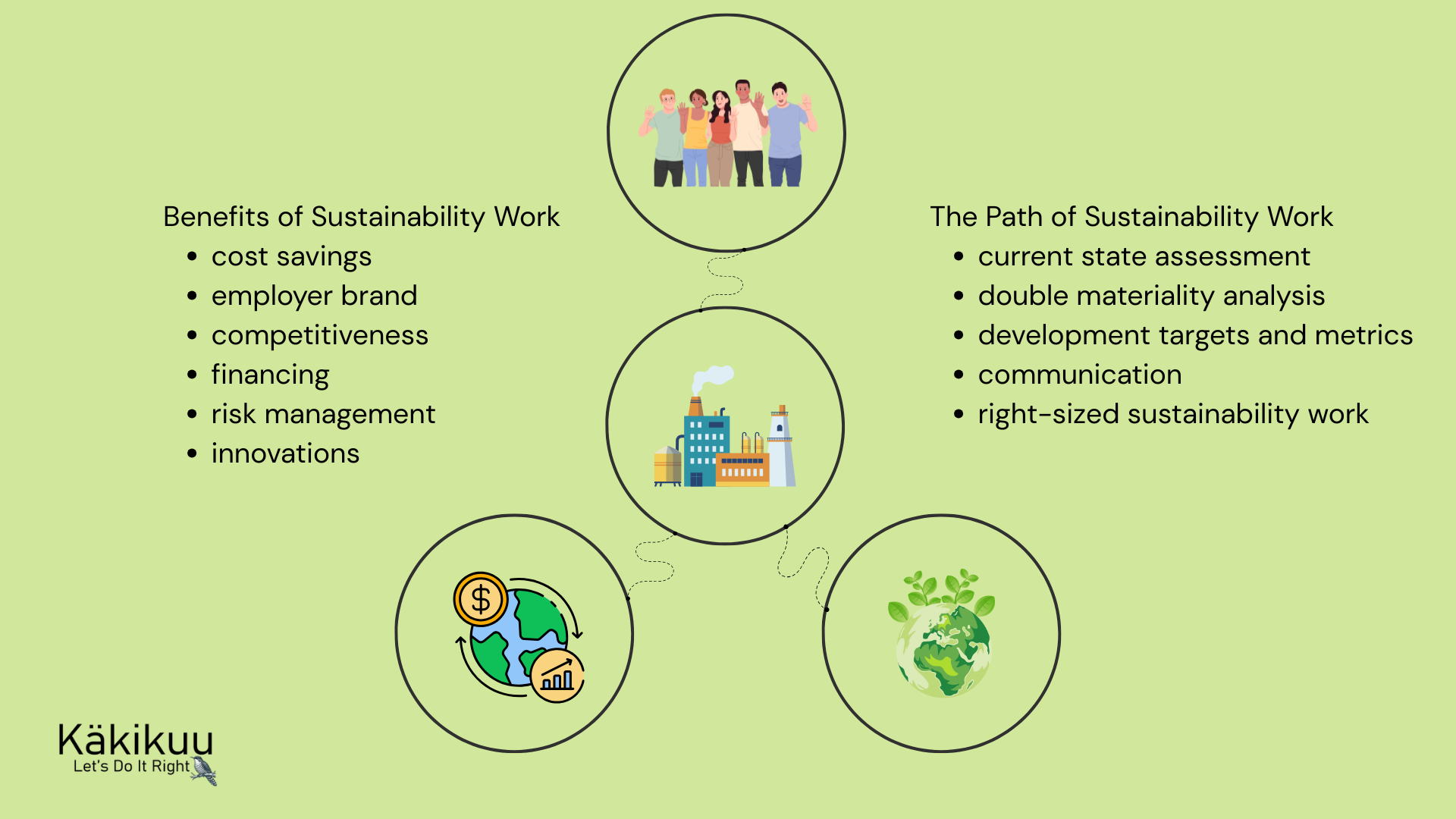Sustainability is becoming an established part of business also for SMEs. The 2025 sustainability trends set clear directions for corporate sustainability efforts, which SMEs should prepare for—especially in light of tightening regulation, changing customer expectations, and technological advancement. Here are a few perspectives on sustainability trends and tips for SME sustainability work in 2025.
–
1. Tightening regulation and its impact on SMEs
In 2025, sustainability reporting obligations will expand significantly, especially due to the EU’s Corporate Sustainability Reporting Directive (CSRD). Although the directive’s requirements apply to large companies, its direct and indirect impacts on SMEs are increasing rapidly, particularly through supply chains.
SMEs must be prepared for large clients to require information such as carbon footprint, working conditions, and human rights. This may feel challenging for SMEs that do not have the resources to hire sustainability experts within their organization. Therefore, SMEs should focus on simple and clear operating models that highlight the company’s key impacts, risks, and opportunities from a sustainability perspective.
- Tip: Use external experts to lighten the workload and ensure that the company’s sustainability work and reporting are relevant and effective. This saves time, money, and your nerves.
–
2. Respond to growing customer expectations
SMEs have a unique opportunity to meet consumer expectations, as their smaller size often allows for more agile responses and more personal customer relationships. Consumers increasingly value transparency, local operations, and concrete sustainability actions.
SMEs can benefit from sustainability by offering locally produced products, following circular economy principles, and openly communicating the impacts of their operations. This allows them to stand out from larger competitors who may struggle with transparency and agility.
- Tip: Make your sustainability efforts visible. Use your website, social media channels, and packaging materials to communicate concrete actions, such as environmentally friendly production or support for local communities.
Make your sustainability efforts visible.
–
3. Circular economy opportunities for SMEs
The importance of the circular economy is growing, and SMEs can take advantage of this trend in many ways. For example, companies in manufacturing and service sectors can develop models where products are repaired, remanufactured, or recycled. This saves costs and creates new revenue streams.
SMEs that integrate circular economy principles into their operations can reduce their environmental impact and increase customer loyalty. Customers value companies that help them make sustainable choices.
- Example: an SME that offers repair services or rents out equipment can simultaneously build a sustainability brand and attract environmentally conscious customers.
–
4. The role of technology in SME sustainability work
Technological advancements, such as the use of artificial intelligence and data analytics, are opening new doors for SMEs as well. For example, AI can help monitor energy consumption or predict supply chain risks. Many technologies, such as the Internet of Things and cloud-based calculation tools, are becoming increasingly affordable and accessible for SMEs. This makes sustainability efforts easier to manage.
- Tip: Start small. Use tools such as energy management apps or carbon footprint calculators to help make sustainability measurable.
Start small.
–
5. Employer branding and sustainability in SMEs
SMEs can use sustainability as a competitive advantage in employer branding as well. Since work communities in SMEs are often more close-knit and flexible, they can more easily create environments where employees feel valued and find their work meaningful.
Employees appreciate companies that invest in environmentally friendly practices, employee well-being, or supporting the local community. This can help attract talent, especially from younger generations for whom sustainability is an increasingly important factor when choosing an employer.
–
6. The role of SMEs in regional sustainability
SMEs are often closely connected to local communities, which gives them a unique opportunity to make a regional impact through their sustainability efforts. For example, cooperation with local educational institutions, organizations, or other SMEs can promote the well-being of both the company and the community.
SMEs can also benefit from regional sustainability initiatives that offer support and funding for sustainability investments.
- Example: an SME can develop locally produced products made from recycled materials and offer sustainable services in collaboration with regional partners. This strengthens both the company’s sustainability image and the vitality of the local area.
–
SME sustainability work is at a turning point, and the 2025 sustainability trends bring new opportunities. It is important to focus on actions that are scalable and support business sustainability without creating unnecessary burden. Tightening regulation, consumer expectations, and technological development can all work in favor of SMEs—when approached strategically.
SMEs should view sustainability trends as opportunities to strengthen customer relationships, improve efficiency, and create a positive impact in their communities. In doing so, they build sustainable and successful business in the long term.



